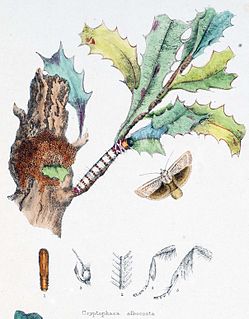Related Research Articles
Stenoma hemiphanta is a moth of the family Depressariidae. It is found in Amazonas, Brazil.
Cryptophasa phaeochtha is a moth in the family Xyloryctidae. It was described by Edward Meyrick in 1925. It is found on New Guinea.
Cryptophasa hormocrossa is a moth in the family Xyloryctidae. It was described by Edward Meyrick in 1925. It is found on New Guinea.
Cryptophasa mesotoma is a moth in the family Xyloryctidae. It was described by Edward Meyrick in 1925. It is found on Buru in the Maluku Islands.
Cryptophasa chionotarsa is a moth in the family Xyloryctidae. It was described by Edward Meyrick in 1925. It is found on New Guinea.
Cryptophasa ensigera is a moth in the family Xyloryctidae. It was described by Edward Meyrick in 1925. It is found on New Guinea.
Cryptophasa oecodoma is a moth in the family Xyloryctidae. It was described by Edward Meyrick in 1930. It is found on New Guinea.
Cryptophasa pseudogramma is a moth in the family Xyloryctidae. It was described by Edward Meyrick in 1930. It is found on New Guinea.
Cryptophasa rubra is a moth in the family Xyloryctidae. It was described by Edward Meyrick in 1890. It is found in Australia, where it has been recorded from South Australia, Victoria and Western Australia.
Cryptophasa sarcinota is a moth in the family Xyloryctidae. It was described by Edward Meyrick in 1890. It is found in Australia, where it has been recorded from Queensland.

Cryptophasa albacosta, the small fruit tree borer, is a moth in the family Xyloryctidae. It was described by John Lewin in 1805. It is found in Australia, where it has been recorded from New South Wales, Queensland, South Australia, Tasmania and Victoria.
Antaeotricha aglypta is a moth in the family Depressariidae. It was described by Edward Meyrick in 1925. It is found in Guyana and Brazil.
Antaeotricha gymnolopha is a moth in the family Depressariidae. It was described by Edward Meyrick in 1925. It is found in Brazil.
Antaeotricha haplocentra is a moth in the family Depressariidae. It was described by Edward Meyrick in 1925. It is found in Brazil.
Antaeotricha milictis is a moth in the family Depressariidae. It was described by Edward Meyrick in 1925. It is found in Colombia and Brazil.
Antaeotricha nimbata is a moth in the family Depressariidae. It was described by Edward Meyrick in 1925. It is found in Peru.
Antaeotricha plerotis is a moth in the family Depressariidae. It was described by Edward Meyrick in 1925. It is found in Peru.
Antaeotricha tornogramma is a moth in the family Depressariidae. It was described by Edward Meyrick in 1925. It is found in Brazil.
Antaeotricha xuthosaris is a moth in the family Depressariidae. It was described by Edward Meyrick in 1925. It is found in Brazil.
Promenesta leucomias is a moth in the family Depressariidae. It was described by Edward Meyrick in 1925. It is found in Pará, Brazil.
References
- ↑ Savela, Markku, ed. (April 25, 2016). "Cryptophasa nesograpta Meyrick, 1925". Lepidoptera and Some Other Life Forms. Retrieved August 24, 2020.
- ↑ Exotic Microlepidoptera. 3 (5-7): 150.
| This article on a moth of the family Xyloryctidae is a stub. You can help Wikipedia by expanding it. |